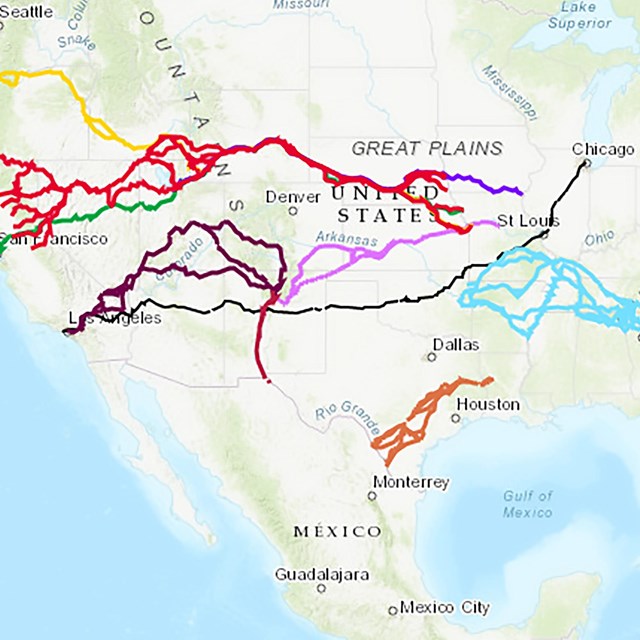Last updated: May 21, 2023
Article
Trail of Tears: Tennessee Itinerary
After Cherokee were forcibly removed from their homes they were marched to temporary camps and forts. The next phase sent them to larger departure camps in Tennessee. Cherokee were assigned to detachments that were organized by military or Cherokee leaders. The first three military-led detachments left on the water route, but disease, desertions, and fatalities caused Cherokee leaders to request permission to organize their own removal detachments and travel overland. You can visit several of the departure locations.
These sites also provide a glimpse of the Cherokee homeland.
This itinerary connects to the Find Your Park! Georgia, Tennessee, Alabama rack card.
Trip Itinerary
- Trail Of Tears National Historic Trail
Audubon Acres, Chattanooga
- Trail Of Tears National Historic Trail
Brainerd Mission Cemetery, Chattanooga

The American Board of Commissioners for Foreign Missions developed the area surrounding the site originally as a mission within the Cherokee Nation. The property, buildings, and improvements were purchased from John McDonald, the grandfather of Cherokee Chief John Ross. The mission was the principal mission among other, smaller ones within the Cherokee Nation, and served as a training ground for American Board staff.
- Trail Of Tears National Historic Trail
Browns Ferry Tavern, Chattanooga

Cherokee leader John Brown, who owned 640 acres in this area, ordered the construction of Browns Ferry Tavern in 1803. By the 1830s, Brown's land formed the boundary of the Cherokee Nation. In 1838, the road running past this structure was the route by which several Cherokee detachments were removed to present-day Oklahoma.
- Trail Of Tears National Historic Trail
John Ross House and Association History Museum
Cherokee Nation leader John Ross lived in this cabin between 1808 and 1827. Its location is not original; in the 1960s it was moved a short distance to the southwest. His house, now owned by a local nonprofit organization, was declared a National Historic Landmark in 1973.
- Trail Of Tears National Historic Trail
Ross's Landing

Ross’s Landing was the departure point for the first groups of Cherokees forced from their homeland on the Trail of Tears in 1838. Today, visitors can explore this scenic public park, view an art installation celebrating Cherokee culture, connect to walking and biking routes, and attend community events on the waterfront.
- Trail Of Tears National Historic Trail
Hiwassee River Heritage Center

This visitor center and art gallery, opened in May 2013, is owned by the Charleston-Calhoun Hiwassee Historical Society and is managed in conjunction with the Cleveland/Bradley Chamber of Commerce. The facility features a large number of interpretive panels that tell the story of the Trail of Tears in Charleston (a key removal site) and elsewhere in eastern Tennessee.
- Trail Of Tears National Historic Trail
John Martin House
This property, and several of its improvements, is linked to Cherokee leader John Martin. Martin built the main house (on the opposite side of Dalton Pike) approximately 1835 after being driven out of Murray County, Georgia. Martin, who has been described as "a distinguished judge in the courts of the Cherokee Nation, and also the national treasurer," was forced to sell his property in 1837, just prior to the Cherokee Removal.
- Trail Of Tears National Historic Trail
Red Clay State Historic Park

Blue Hole Spring, a natural landmark in the park, was used by the Cherokee for their water supply during council meetings. The 260-acre park contains a visitor center (James F. Corn Interpretive Center), theater, library, amphitheater, picnic shelter, and hiking trails. Replicas of 19th-century Cherokee buildings include a council house, farmhouse, barn, corn crib, and three sleeping huts.
- Trail Of Tears National Historic Trail
Cherokee Removal Memorial Park at Historic Blythe Ferry
Cherokee Removal Memorial Park is a multipurpose facility dedicated to those that died and those that cried in what has become known as the "Trail of Tears". The park is intended to interpret and educate the public about the forced removal of the Cherokees from their ancestral land as well as inform them about the unique wildlife in the area and provide recreational opportunities. The Park is located at the mouth of the Hiwassee River.
- Trail Of Tears National Historic Trail
Hair Conrad Cabin
Hair Conrad was a Cherokee leader during the 1820s and 1830s. In 1838, he was selected to lead the first Cherokee detachment, which traveled the main (northern) route from Rattlesnake Springs (near Charleston, TN) to Indian Territory. This 20-foot by 22-foot two-story cabin was built about 1804, and except for the later addition of a kitchen, this log building still looks much as it did during the 30-plus years that Conrad lived here.









